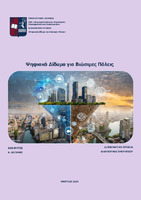Ψηφιακά δίδυμα για βιώσιμες πόλεις

View/
Keywords
Ψηφιακά δίδυμα ; Βιώσιμες πόλεις ; ΠαρατηρητήριοAbstract
The term "Digital Twin" emerged in the scientific community in 2002, was first applied by NASA in 2012 and since then has consistently held its own place in Gartner's list of the top 10 strategic trends every year. The "Digital Twin" concept has been applied with great success in many sectors with the aim of saving energy, which implies a reduced carbon footprint and lower operating costs, and has already been applied in the field of sustainable cities since 2018, hence the new term "Digital Twin City" proposed in 2021 by the World Economic Forum.
A "Digital Twin City" is the digital analogue of a physical object, which can range from a campus of buildings and critical infrastructures or a neighborhood to a whole city or even a whole country, as in the case of Singapore. It describes and monitors the physical object in the digital world, combining 3D geospatial imagery with the collection of static or dynamic data, with which it feeds mathematical models in order to perform calculations leading to predictions, rankings, prioritization, optimization and all types of analysis to extract useful information and patterns, supporting the physical city's management authority in making decisions, automated or not, short or long term, contributing to a sustainable future for the city and its citizens.
The present diploma thesis researched and studied 107 active examples of the "Digital Twin City" concept across the world with a unified approach, seeking for each example of the "Digital Twin City" answers to common questions such as: How its physical object was defined, What is its purpose and how it relates to the city's sustainability strategy, What technological means were adopted, With which data sources it is interconnected and how are they related to each other, What was its budget and what was its timeline, What governance and what funding models were chosen, in order to compare and evaluate the 107 examples, with the aim of extracting and sharing information, useful for all those involved in roles of designing, implementing and/or operating applications of the "Digital Twin City" concept.
The knowledge generated was channelled into the "Digital Twin Cities Observatory", the application of the same name, which was developed, within the framework of the present diploma thesis, on the online platform ArcGIS ®, and which aims to become a manual for the creation of new or for the optimization of existing applications of the "Digital Twin City" concept, both through its 3 tools: Ideation Tool, Blueprint Tool and Technology Provider Ecosystem Tool for "Digital Twin Cities", as well as through the application of the Maturity Index as an evaluation tool for each "Digital Twin City". The Maturity Index is the proposal of present diploma thesis as to which criteria are recommended to be taken into account in the design, implementation and evolution of an application of the "Digital Twin City" concept.
The aim is that the findings of this research are taken into account in the design of future “Digital Twin Cities” and that the findings from each future “Digital Twin City” are incorporated into the “Digital Twin Cities Observatory”, enhancing its value as a decision-making tool for such complex and necessary systems as the “Digital Twin City”, the 'system of systems' for the sustainable city.


